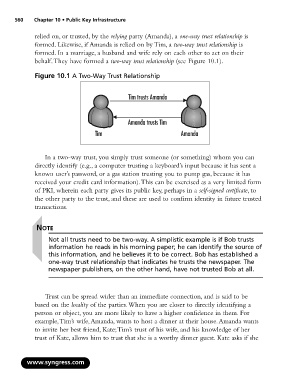Page 576 - StudyBook.pdf
P. 576
560 Chapter 10 • Public Key Infrastructure
relied on, or trusted, by the relying party (Amanda), a one-way trust relationship is
formed. Likewise, if Amanda is relied on by Tim, a two-way trust relationship is
formed. In a marriage, a husband and wife rely on each other to act on their
behalf.They have formed a two-way trust relationship (see Figure 10.1).
Figure 10.1 A Two-Way Trust Relationship
Tim trusts Amanda
Amanda trusts Tim
Tim Amanda
In a two-way trust, you simply trust someone (or something) whom you can
directly identify (e.g., a computer trusting a keyboard’s input because it has sent a
known user’s password, or a gas station trusting you to pump gas, because it has
received your credit card information).This can be exercised as a very limited form
of PKI, wherein each party gives its public key, perhaps in a self-signed certificate,to
the other party to the trust, and these are used to confirm identity in future trusted
transactions.
NOTE
Not all trusts need to be two-way. A simplistic example is if Bob trusts
information he reads in his morning paper; he can identify the source of
this information, and he believes it to be correct. Bob has established a
one-way trust relationship that indicates he trusts the newspaper. The
newspaper publishers, on the other hand, have not trusted Bob at all.
Trust can be spread wider than an immediate connection, and is said to be
based on the locality of the parties.When you are closer to directly identifying a
person or object, you are more likely to have a higher confidence in them. For
example,Tim’s wife,Amanda, wants to host a dinner at their house.Amanda wants
to invite her best friend, Kate;Tim’s trust of his wife, and his knowledge of her
trust of Kate, allows him to trust that she is a worthy dinner guest. Kate asks if she
www.syngress.com

